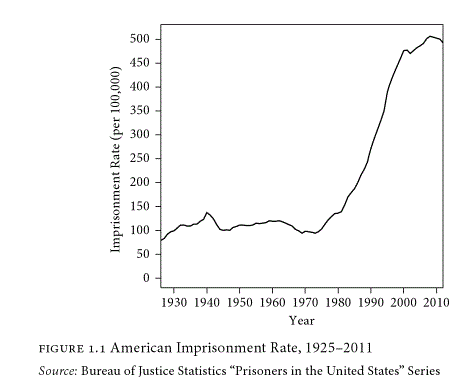At 716 per 100,000 people (2013 figures), the U.S. has the highest incarceration rate in the world. The number of Americans behind bars is now well over two millions--around 25 percent of the world's prisoners. This is a relatively new phenomenon: throughout the first three quarters of the twentieth century the country's incarceration rate remained relatively stable, at about 110 per 100,000 people. Things changed in the mid-1970s, when the rate began to climb, doubling in the 1980s and then again in the 1990s, before slowing down and leveling off in the first decade of the 21st century. This unprecedented surge in imprisonment has been dubbed the "prison boom."
The mapmakers at MapStory, a non-profit online, open-source mapping platform, have given us another way to visualize this phenomenon. The massive increase in the number of prisoners was accompanied by an equally massive number of new prisons built to house them: while the period 1811-1979 saw the construction of 711 prisons, 936 prisons were built between 1980 and 2004. Using data compiled by Rose Heyer at the Prison Policy Initiative, MapStory created a time-lapse map (http://mapstory.org/maps/933/#full) showing prisons built in the U.S. between 1811 and 2004. Users can play the animation starting in 1811 and watch the slow build-up of prisons between 1811 and 1979 (white circle dots on the map) and the acceleration in prison construction between 1980 and 2004 (black circle dots), as well as freeze the map on specific years and zoom in on specific states or regions.
Read more:
http://mapstory.org/maps/933/#full
http://mapstory.org/
http://www.prisonpolicy.org/atlas/proliferation1900-2000.html
TeachingwithData.org resources:
Prisoners per Capita (http://www.teachingwithdata.org/resource/2979)
Fear of Crime (http://www.teachingwithdata.org/resource/3155)
Crime Victimization in the US: A Data-Driven Learning Guide (http://www.teachingwithdata.org/resource/3437)
Unknown
About TeachingwithData.org
TeachingWithData.org is a partnership between the Inter-university Consortium for Political and Social Research (ICPSR) and the Social Science Data Analysis Network (SSDAN), both at the University of Michigan. The project is funded by NSF Award 0840642, George Alter (ICPSR), PI and William Frey (SSDAN), co-PI.
Translate
Search This Blog
Popular Posts
-
A study recently featured in the Journal of Comparative Economics examines income inequality in urban China. Capital income increased d...
-
According to the Washington Post, since 2009, the unemployment rate in the United States has dropped by 50% . The traditional...
-
A recent post on the Economist’s Graphic Detail blog includes a global map of cigarette smokers in 2010, as reported by the American Cance...
-
If you’ve hit the point in the semester where your classes have fallen into routines and you’d like to spice things up a bit, this webinar i...
-
The month of March signaled the beginning of National Women’s History Month, as well as the annual Oscar Awards ceremony, which was held on...








No comments :
Post a Comment